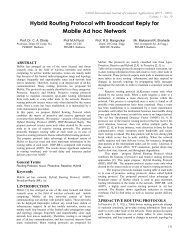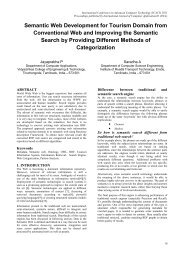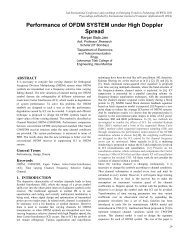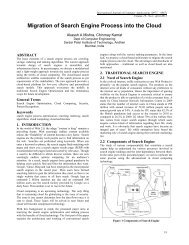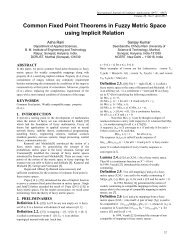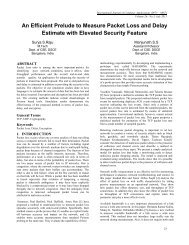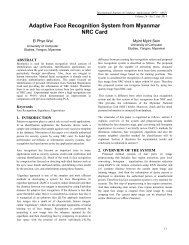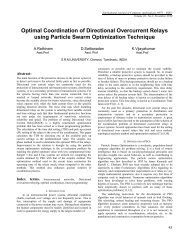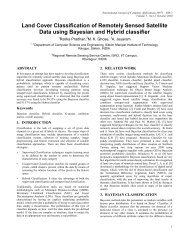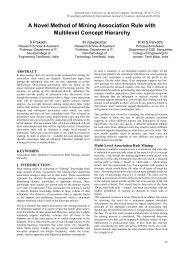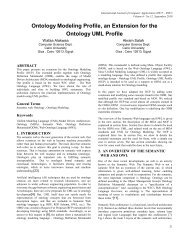IJCA Template - International Journal of Computer Applications - IJCA
IJCA Template - International Journal of Computer Applications - IJCA
IJCA Template - International Journal of Computer Applications - IJCA
Create successful ePaper yourself
Turn your PDF publications into a flip-book with our unique Google optimized e-Paper software.
<strong>International</strong> <strong>Journal</strong> <strong>of</strong> <strong>Computer</strong> <strong>Applications</strong> (0975 – 8887)<br />
Volume 7– No.7, October 2010<br />
J P(B<br />
i<br />
/ c<br />
j<br />
1) P(B<br />
0<br />
/ c<br />
j<br />
1)<br />
<br />
LLR<br />
j<br />
ln ln<br />
<br />
i1<br />
P(B<br />
i<br />
/ c<br />
j<br />
0) P(B<br />
0<br />
/ c<br />
j<br />
0)<br />
<br />
According to [9], (6) can be expressed as<br />
j 0 0 i i<br />
i1<br />
J<br />
LLR (1 2B )w (1 2B )w<br />
(7)<br />
where the value <strong>of</strong> ( 1 2B i<br />
) is equal to +1 or –1 and wi<br />
is a<br />
weighting term proportional to the reliability <strong>of</strong> the i th orthogonal<br />
parity check. It is easy to show that:<br />
4E<br />
(1 2B )w r<br />
and<br />
w<br />
s<br />
0 0 j<br />
N0<br />
ni<br />
<br />
1 tanh(L / 2)<br />
<br />
<br />
<br />
ik<br />
k1<br />
i<br />
ln ni<br />
<br />
1<br />
tanh(L<br />
ik<br />
/ 2) <br />
k1<br />
<br />
where ik represents the k th element <strong>of</strong> the i th parity equation and<br />
L<br />
4E<br />
s<br />
r . (10)<br />
ik<br />
ik<br />
N<br />
0<br />
Thus the s<strong>of</strong>t output can be split into two terms, namely into a<br />
normalized version <strong>of</strong> the s<strong>of</strong>t input r and an extrinsic<br />
information E representing the estimates made by the orthogonal<br />
j<br />
bits on the current bit c . Hence (7) becomes<br />
s<br />
j j j<br />
N0<br />
j<br />
4E<br />
LLR r E<br />
(11)<br />
We make the following notations:<br />
L<br />
4E<br />
s<br />
c<br />
, (12)<br />
N0<br />
which is called the reliability value <strong>of</strong> the channel.<br />
The algorithmic structure <strong>of</strong> the SISO threshold decoding can be<br />
summarized as follows:<br />
For each<br />
j 1,..,<br />
n<br />
Compute the terms<br />
B<br />
i<br />
and<br />
Calculate B and<br />
0<br />
W<br />
0<br />
Compute the extrinsic information<br />
The S<strong>of</strong>t-output is obtained by:<br />
w , i<br />
1,..,J<br />
<br />
i<br />
E<br />
j<br />
LLR<br />
j<br />
Lcrj E<br />
j<br />
2.4 Modifications for Rayleigh fading channel<br />
For our algorithm to be applicable in wireless environment, their<br />
performance on fading channels must be examined. In the channel<br />
model we use, each received bit r j can be expressed as:<br />
r a cˆ<br />
n<br />
(13)<br />
j j j j<br />
In this representation, ĉ<br />
j is a BPSK symbol associated to the<br />
transmitted bit c j , and n j is an AWGN. The Rayleigh variable a j is<br />
j<br />
(6)<br />
(8)<br />
(9)<br />
generated as<br />
a x y<br />
(14)<br />
2 2<br />
j j j<br />
where x j and y j are zero mean statistically independent Gaussian<br />
random variables each having a variance 2 . We consider the<br />
power normalized to one as<br />
2 2<br />
Ea <br />
<br />
2<br />
1<br />
j <br />
(15)<br />
which give a variance <strong>of</strong> 0.5 for Gaussien variables.<br />
On the Rayleigh fading channel, the availability <strong>of</strong> channel<br />
side information is the key issue in determining the necessary<br />
modification for the iterative threshold decoding algorithm. The<br />
threshold decoding algorithm has to be modified slightly by<br />
changing equation (12) which define the reliability value <strong>of</strong> the<br />
channel by<br />
4E<br />
L s<br />
c<br />
a<br />
(16)<br />
j<br />
N<br />
0<br />
3. ITERATIVE THRESHOLD DECODING<br />
3.1 Iterative Threshold Decoding <strong>of</strong> OSMLD<br />
codes<br />
Iterative decoding process (see Fig. 1) can be described as<br />
follows: In the first iteration, the decoder only uses the channel<br />
output as input, and generates extrinsic information for each<br />
symbol. In subsequent iterations, a combination <strong>of</strong> extrinsic<br />
information and channel output is used as input<br />
E (q)<br />
(q)<br />
The s<strong>of</strong>t input respectively the s<strong>of</strong>t output <strong>of</strong> the q th iteration is<br />
given by:<br />
R(q) R (q)E(q)<br />
(17)<br />
LLR(q) L R(q) E(q 1)<br />
(18)<br />
c<br />
E ( q 1)<br />
R (q) SISO-<br />
Threshold<br />
LLR ( q 1)<br />
Decoder<br />
R<br />
Fig. 1: The block diagram <strong>of</strong> the q th iteration.<br />
where R represent the received data, E(q) is the extrinsic<br />
information computed by the previous iteration. In our procedure<br />
we use a fixed value 1/J for the parameter (q)<br />
and this for all<br />
iterations. The value chosen for (q)<br />
reacts as an average <strong>of</strong> all J<br />
estimators which contribute in the computation <strong>of</strong> E j .<br />
3.2 Iterative Threshold Decoding <strong>of</strong> product<br />
codes<br />
The developed algorithm can also be applied to product codes and<br />
parallel concatenated codes based on block codes. Let us consider<br />
two linear block codes C 1 having parameters ( n<br />
1<br />
, k<br />
1<br />
, d<br />
1<br />
) and C 2<br />
having parameters ( n ,<br />
2<br />
k ,<br />
2<br />
d ) where<br />
2<br />
n ,<br />
i<br />
k and<br />
i<br />
d (i =1,2)<br />
i<br />
stand for codeword length, number <strong>of</strong> information bits and<br />
minimum Hamming distance respectively. It is assumed that the<br />
14



